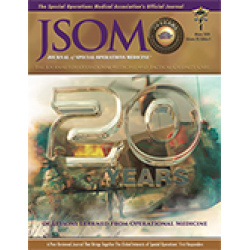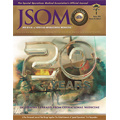Life and Limb In-Flight Surgical Intervention: Fifteen Years of Experience by Joint Medical Augmentation Unit Surgical Resuscitation Teams
DuBose JJ, Stinner DJ, Baudek A, Martens D, Donham B, Cuthrell M, Stephens T, Schofield J, Conklin CC, Telian S 20(4). 47 - 52 (Journal Article)
Background: Expedient resuscitation and emergent damage control interventions remain critical tools of modern combat casualty care. Although fortunately rare, the requirement for life and limb salvaging surgical intervention prior to arrival at traditional deployed medical treatment facilities may be required for the care of select casualties. The optimal employment of a surgical resuscitation team (SRT) may afford life and limb salvage in these unique situations. Methods: Fifteen years of after-action reports (AARs) from a highly specialized SRTs were reviewed. Patient demographics, specific details of encounter, team role, advanced emergent life and limb interventions, and outcomes were analyzed. Results: Data from 317 casualties (312 human, five canines) over 15 years were reviewed. Among human casualties, 20 had no signs of life at intercept, with only one (5%) surviving to reach a Military Treatment Facility (MTF). Among the 292 casualties with signs of life at intercept, SRTs were employed in a variety of roles, including MTF augmentation (48.6%), as a transport capability from other aeromedical platforms, critical care transport (CCT) between MTFs (27.7%), or as an in-flight damage control capability directly to point of injury (POI) (18.2%). In the context of these roles, the SRT performed in-flight life and limb preserving surgery for nine patients. Procedures performed included resuscitative thoracotomy (7/9; 77.8%), damage control laparotomy (1/9; 11.1%) and extremity fasciotomy for acute lower extremity compartment syndrome (1/11; 11%). Survival following in-flight resuscitative thoracotomy was 33% (1/3) when signs of life (SOL) were absent at intercept and 75% (3/4) among patients who lost SOL during transport. Conclusion: In-flight surgery by a specifically trained and experienced SRT can salvage life and limb for casualties of major combat injury. Additional research is required to determine optimal SRT utilization in present and future conflicts.


 Español
Español 




